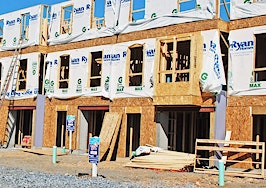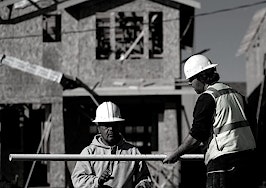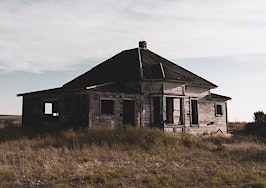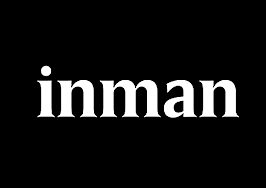There are plenty of upsides to purchasing a new build, namely the opportunity for complete customization and the happiness that comes with being the first homeowner. However, those upsides come with a few hurdles, such as properly understanding pricing, navigating financing and dealing with project setbacks.
Before embarking on the journey of purchasing a new build, here’s what your client needs to know:
1. Purchasing a new build is often more complicated

Bill Gassett
Massachusetts-based real estate agent Bill Gassett says the biggest misconception buyers have about purchasing a new build that it’s somehow easier than purchasing an existing home because there’s no need to haggle with sellers and calculate the costs of renovations or repairs.
However, new builds come with unique issues of their own, such as choosing the right builder and keeping the project on track and on budget.
“Probably one of the most stressful parts of building a house that can happen is the builder doesn’t complete the project on time,” Gassett said. “It happens more so than people think.”
In that case, buyers need to align the sale of their current home with project deadlines as close as possible (with some leeway) and have plans for temporary housing if the builder fails to meet the original deadline.
2. You’ll likely pay more than the advertised price
Unlike existing homes, the pricing for new homes isn’t always as clear. Builders will often advertise the price for their base home, while wowing buyers with souped-up model homes. As a result, some buyers will assume the advertised base price at the subdivision’s gates is for the model home when it’s not.
“A lot of times, the model home is decked out with things that aren’t necessarily standard features,” Gassett said. “The builder puts every imaginable extra under the sun in the model home to make it look its absolute best, and sometimes buyers walk in and think everything that’s there is what they’re going to get. Quite often it’s not that way.”

Cara Ameer
Real estate broker Cara Ameer says it’s important to explain the difference between the pricing for the base home and the model home, and that final pricing takes time, especially if you decide to purchase upgrades and choose a premium lot.
“Determining the final pricing on a home will take time,” Ameer wrote for Inman in August. “The initial pricing a buyer is quoted typically reflects the base price of the home, plus the lot if there is a premium being charged due to the type of lot — if it is private (such as a conservation lot), located on a cul-de-sac or has a view such as overlooking water, golf course, etc.”
3. Prepare for the cost of upgrades
Just like it’s smart to have a cushion for upgrades made to an existing home, it’s even more important to have that cushion for a new build.
“If you start going through and adding things that you feel you have to have, the price can shoot up quite a bit, and far more than you expected,” Gassett said. “Buyers need to know they need a cushion of additional expenses above what they expect to pay. There are always overruns.”
Gassett says builders will provide a list of upgrades and their costs before construction begins. Some upgrades are determined before construction starts; other upgrades, such as flooring, cabinets and other finishes may be chosen or revised after the project has started.
With this in mind, Gassett suggests buyers have a project cushion that’s equal to 5-10 percent of the home’s final pricing. This gives buyers room to make changes (natural wood flooring instead of laminate wood flooring) that cost more.
Furthermore, Ameer says some builders may charge a fee for each change that’s made, so it’s important buyers have a full understanding of the fees before the project begins.
“If a builder can accommodate a change, there could be a fee charged for it,” she said. “It’s best to find out when first discussing options and upgrades what kind of fees would apply if that should happen.”
4. It’s not a requirement to use the builder’s preferred lender
Builders often have a preferred lender and will offer buyers attractive lending packages. In this case, buyers can feel pressured to go with the builder’s preferred lender, but it’s important they understand the builder cannot force them to.
“It’s against the law to make someone go to a specific lender,” Gassett noted.

Jeff Gould
Florida-based Realtor Jeff Gould says builders encourage buyers to choose the preferred lender as a way to reduce their financial risk because buyers aren’t required to secure a construction loan or offer a larger down payment.
“After all we just went through with the real estate downturn, I am amazed that builders do not require buyers to use construction loans or require larger down payments,” Gould said in a previous Inman article. “Because they do not need these items, there is a huge financial risk for builders when they build a new home. Using the preferred lender reassures the builder that the buyer is a good credit risk.”
Gould and Gassett suggest buyers review all their loan options, and if the builder truly offers the best loan, then feel free to go with it.
“Depending on the incentives the builder is offering, using the builder’s lender might be an excellent option for a buyer,” Gould added.
5. You have the right to an agent
Builders, especially those with a national presence, often have their own in-house real estate team that provides tours of the model home, provides details on lot availability, and explains pricing, contracts and other things. But, it’s important to note these agents represent the builder — not buyers.
Ameer says some builders’ agents may tell buyers there’s no need for agent representation and may hint that’ll save them money if they forego having an agent.
“Buyers should be leery of any site agent who frowns or discourages them from having their own agent or attempts to minimize their need for one,” she said. “Some site agents will go so far as to suggest that buyers can save them money by not having an agent.”
Although the decision is ultimately up to the buyer, Ameer says buyers should strongly consider having an agent by their side from the very beginning. That way, the agent can accompany buyers to home and subdivision tours, provide comparative market analyses, research builders, read contracts and help with negotiations.
“It is important for buyers to involve an agent before their first visit to a new construction community and always mention the specific agent they are working with to any site agent that they may be having communications with,” Ameer added. “Many builder policies require that the buyer’s agent accompany the customer on their first visit and that they be properly registered to that agent.”
Furthermore, Gassett says builders typically pay the buyer’s agent commission — another great reason for buyers to have their own agent.
6. You can save money and time by purchasing the model home
Builders often won’t budge on their pricing, leaving some buyers discouraged. But, Gassett and Gould say model homes offer a silver lining.
“I’ve seen model homes been sold at various points, but most often, they’ll be sold when the subdivision is near completion,” Gassett explained. “Sometimes a buyer can get a pretty decent deal because the builder doesn’t need to hold on to the house at that point and doesn’t need to get every penny out of the house.”
“It’s going to have a little wear and tear on it, depending on how long the project has been going on,” he said as a caveat to the savings. “If it’s been a couple years, then tons of people have walked through the house, so it’s not going to look the same as a brand new house.”
Gould also says it’s important to note buyers will lose the options for customization, and that builders aren’t obligated to make changes.
“The one downside of buying the model home is that the buyer generally does not get to pick the floor coverings, the color of the paint on the walls, the kitchen cabinets, appliances or any fixtures,” he added. “In many ways, it is like buying a professionally designed resale home.”
Despite those two “downsides,” Gould says model homes have a great resale value, making them a good option if you move quick enough.
7. Market slowdowns are the perfect time to purchase
Although spring is the perfect time to hunt for existing homes, winter is the prime season for getting a new build at a discounted price.
Gassett says builders are often more willing to negotiate when the buying season slows down, which is during the winter for most regions.
“It ultimately depends on what the market is like,” he said. “But if a builder wants to offload inventory for the spring and make room for another set of new builds, it could be a good time to negotiate.”







